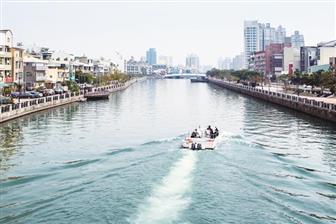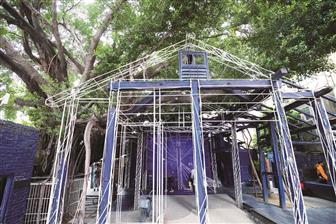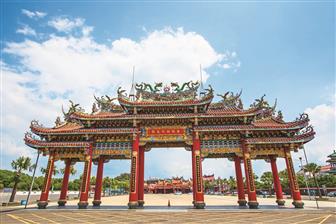The city of Tainan on the southwest coast is the birthplace of modern Taiwan history. The local population looks upon Tainan - the capital for most of the island's days under imperial Chinese control - as the Japanese do upon ancient Kyoto and the Koreans upon antique Kyongju. The classic Tainan tour, a celebration of the proud legacy embodied in its compelling heritage sites, has in recent years been made that much more rewarding with renovation and/or significant augmentation of sites for the pleasure of both residents and tourists.
The city, various government authorities at the national level, and private citizens are also hard at work comprehensively enhancing local quality of life - and the tourist experience - in other fields. One key area in this quest is the cultural-creative realm; one after another old, narrow shophouse street and neighborhood enclave has been magically transformed into a cultural-creative space teeming with boutique stores, small art galleries, and eclectic restaurants, cafes, and teahouses, with the original architecture and community history respected and celebrated.
On another front, more and more of the coastal area's deep stock of saltwater-focused resources, from lagoons to mangrove swamps to canals leading to harbor and sea - long dedicated almost exclusively to marine-resource industries - are now being rededicated for tourist-drawing eco-learning activities.
Heritage Sites & Tourist Hotspots
Taiwan's modern history began in today's Anping District. And it all began in Anping at the spot today called Anping Fort, site of the ruins of a grand citadel built by the Dutch.
The stronghold, originally called Fort Zeelandia, was built at the north-end head of a great sometimes sandbar/sometimes silt island (at high tide) that jutted out from the mainland. Along with other offshore silt islands, it formed the sea-side wall of a large "Inner Sea." The Dutch sought to rule Taiwan from 1624 to the time they were ousted by the celebrated Ming dynasty loyalist Koxinga in 1662. The Inner Sea eventually silted over, and the fort's ruins are today stranded far from the coast. Much of our theme-tour time in the pages to come is spent where the Inner Sea once rippled, and in the solid land/open water transition area between Anping Fort's position and today's Taiwan Strait coastline.
Right beside Anping Fort are a number of narrow eatery-stuffed streets collectively called Anping Old Street, where seafood is bien sur the compelling draw. This was the site of the first Dutch settlement, "Taiwan's 1st Street" - the first-ever commercial street to form. There are many famed eateries here with long histories; shrimp rolls are an Anping Old Street compulsatory treat, Taiwan's answer to Japan's tempura, and Chou's Shrimp Rolls is one of the best restaurants serving the delicacy.
Just north of Anping Fort is a heritage-architecture tandem only opened to the public in recent years, the Old Tait & Company Merchant House, and directly behind, the Anping Tree House, both built by a British trading firm after the Second Opium War forced China to open ports to Western trade in 1858. The facilities were later abandoned when the Japanese targeted the lucrative opium and camphor trades during their colonial rule of Taiwan. Inside the breezy, graceful arcaded colonial-style trading house are displays on the area's imperial-era history. The treehouse, originally conjoined warehouses, has been completely overrun by massive banyan trees, creating a fairytale maze.
Just south of Anping Fort is the innermost section of Anping Harbor, awaiting tour-boat exploration. Overlooking its south side is a giant 16m-high hilltop statue of Lin Mo-Niang located in the breezy Lin Mo-Niang Park. Lin was the young mortal maiden who became the immortal Mazu, Goddess of the Sea, protector of seafarers.
A few blocks south of the park is the Eternal Golden Castle, actually a fort, built by the Chinese in the 1870s as protection against grasping colonial powers. Designed by a Frenchman, massive bastions are found at the ends of the four high, thick walls, with a moat making enemy access even more difficult. On display inside are giant cannons and archeological digs.
Also recommended are two newer historic attractions not far outside Anping District. The Tainan Judicial Museum complex, inaugurated as the Taiwan District Court in 1914, is considered one of Taiwan's three supreme Japanese-era works of architecture, the others Taipei's Presidential Office Building and National Taiwan Museum. The Japanese used Taiwan as an experimental station, and as with other designs this is an eclectic mix of Western architectural traditions. A dome is its most striking feature, once paired with a tower that soars no more but which is still "on view"- in a room of whimsy with a large replica seen in a deep well that is in fact a reflection of the real thing hanging upside-down from the ceiling.
The Old Taiwan Magistrate Residence, built in 1900, was used as a residence by visiting Japanese royals, most notably the future Emperor Hirohito during his 1923 grand Taiwan inspection. Have your photo taken with him (a life-size cutout) in the history-display area.
Cultural-Creative Youth Culture on Old Streets
Over the past decade or so, a number of historic streets and alleys in Tainan's old neighborhoods long down on their luck have undergone a renaissance, the prime movers young entrepreneurs simultaneously following two dreams: to preserve a chosen bit of the architectural history of the city they love, and to express their cultural-creativity in self-financed business ventures that can provide them a living wage. These long-quiescent enclaves are now alive with artsy-style cafés, teahouses, eateries, boutiques, artist studios, and other interests.
Blueprint Culture and Creative Park (opened in 2015) is a narrow-lane complex of renovated simple, cement-walled dormitories originally built by the Japanese to house judicial-authority employees; the aforementioned Tainan Judicial Museum is nearby. The dorm buildings are today home to an attractive cluster of artisanal outlets and creative eateries. The "blueprint" refers to a mesmerizing entrance-point 3D artwork that transforms a solid wall into a glowing architectural blueprint.
At the western end of old, exceedingly narrow Xinyi Street, which stretches just a few hundred meters, is the small, imperial-style Duiyue Gate. Built in 1836 by China's Qing imperial government, this is the only gate from the old walled city still in use today (note the white stone used for the base, Penghu stone originally used as ballast in ships sailing from the Penghu Islands). In recent years young entrepreneurs have been encamping in this still-bustling neighborhood, rich with traditional shophouse-style heritage residences and three venerable, well-maintained temples.
Yuguang Island, today Tainan's sole offshore island, is a mere stone's throw-plus from the Eternal Golden Castle. It is reached by a short bridge just south of the fortress; the canal-tour boats pass underneath. A raised boardwalk takes visitors through the island's forest cover to along, crescent-shaped outer beach, where people picnic, small sailboats ply the gentle waters, and fishermen move about tending their open-water oyster-farm plots.
A short distance from the coast in Annan District, right above Anping District, is the striking Taijiang National Park Visitor Center. Taijiang National Park is a watery world of estuaries, sandbars, tidal flats, old irrigation canals and small-craft shipping channels, mangrove swamps, wetlands, and aquaculture farms - much of these vestiges of the old Inner Sea. The white-walled buildings of the visitor complex, built on stilts above retired fish farms, resemble traditional fishermen dwellings and circle a faux "lagoon."
North of this is coastal Qigu District, home to the Black-faced Spoonbill Reserve, a key site in the ongoing international campaign to help the magnificent, critically endangered black-faced spoonbill, a water bird that migrates between North Korea to Southeast Asia. North of the reserve is the sea-like Qigu Lagoon, festooned with a veritable Roman legion of aligned oyster racks.
North of Qigu is coastal Beimen District. Just south of the fishing village of Beimen are the Jingzaijiao Tile-paved Salt Fields, Taiwan's oldest salt fields, created in 1818. This site is a showcase example of how the bottom of evaporation ponds were paved with pottery shards, producing cleaner salt and making harvesting easier.
Just north of Beimen village is the grandiose Nankunshen Daitian Temple complex, visible from far off across the flatlands. This is the largest of Taiwan's many temples dedicated to what are called the "plague gods." In imperial times effigies of these gods would be placed on junk sat sickness-stricken places and sent off to sea; temples would often be built to appease them at places the boats drifted ashore. This spot, place name Nankunshen, is said to have been visited by such a craft in 1662.
Vanaheim, a coast-side eco-theme resort, is not far north of the temple. You "camp" here - in simple, sturdy structures resembling yurts, big enough for two beds and a small toilet and shower. The accommodations sit on the edge of a large, busy mangrove forest; tectonic activity has caused some coastal land in this region to subside, and mangroves have been encouraged to once again take root where saltwater aqua farms long flourished.
Included in a visitor's stay package is a guided mangrove-channel boat tour and an eco-tour along a long forest-wending raised boardwalk and the beach/tidal flat between forest and Taiwan Strait.

Anping Fort

Anping Canal

Blueprint Culture and Creative Park

Nankunshen Daitian Temple
DIGITIMES' editorial team was not involved in the creation or production of this content. Companies looking to contribute commercial news or press releases are welcome to contact us.



